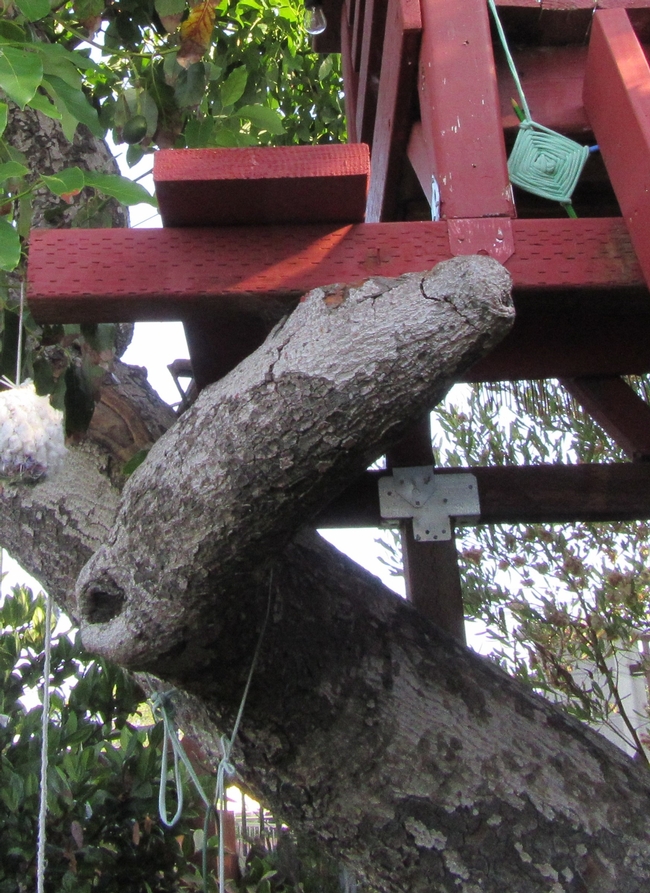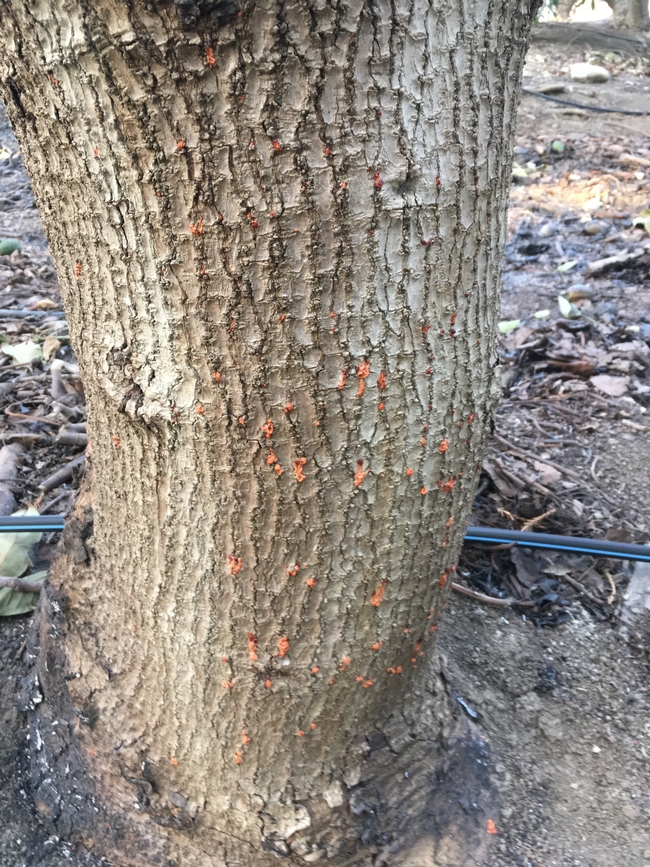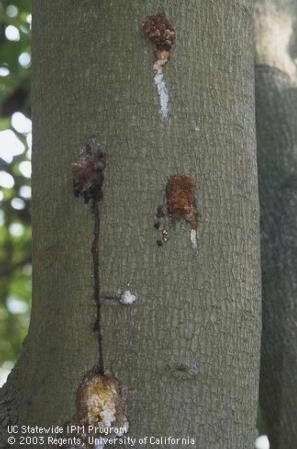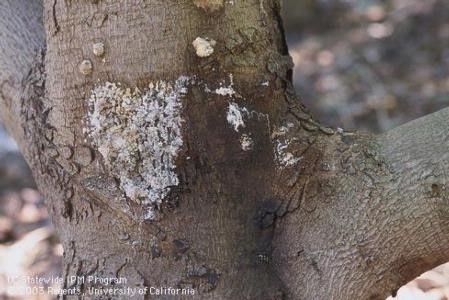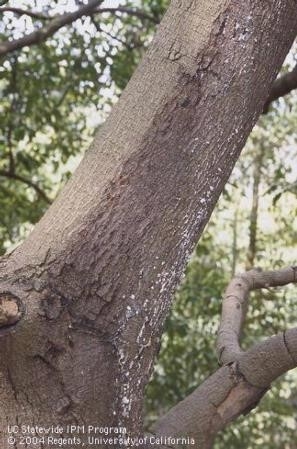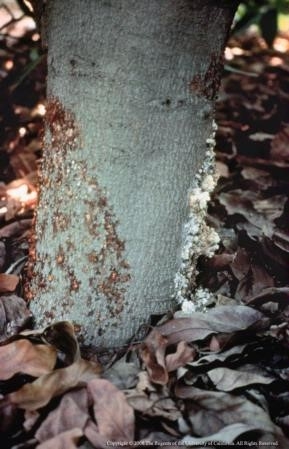There are a number of causes for the white exudate from cankers on the trunk and limbs of avocado. Any wound will cause the tree sap to run and crystalize on the surface. It is a seven-carbon sugar of mannoheptulose, or its alcohol form perseitol. It's sweet. The leaking sap is the tree's attempt to staunch the wound (More about the sugar can be found at: https://www.sciencedirect.com/science/article/pii/S0254629911001372 ). Any wound that might be caused by woodpeckers, pickers or little kids climbing the trees will damage the bark, and where the damage has occurred, the sugar will form. So fire damage can cause wounding and so can insect infestation like shot hole borer. Any wound will cause the sugar to leak out in a response to heal the damage. This sugar exudate is a sing of health in the tree, showing that it can respond to attack/infestation/disease. No response is a bad sign.
Physical damage from kids clambering around in a tree
Fire/heat damage exudate
Shot Hole Borer Damage
There are also diseases that can cause a wound that will exude the sugar sap. Three of these are due to water stress of some form that allows infection to occur. These cankers can be quite a problem in avocado, as well as some other tree species, during drought years. With rainfall, the sugar stain is washed away and if there is adequate rainfall, the cankers might even heal. But they can easily reappear once the right stress conditions reappear. The other tree species don't exude the white sap, which is unique to the laurel family. The cankers have also appeared regularly in orchards that have irrigation and salinity management problems. All of these diseases can lead to unthrifty looking trees, which can lead one to conclude that they have Avocado Root Rot. Often, though the trees can have the cankers and the whole canopy can look quite healthy.
One of these trunk cankers is bacterial – Bacterial Canker –caused by Xanthomonas campestris. The name” campestris” means “field” in Latin, and it is a bacterium commonly found in nature. So the bacterium is widespread, and it is not unusual to see a large part of an orchard infected, but it is not commonly found in most orchards. The infection causes a pocket of infection that will ooze sap. The oozing pockets will often appear in a series along a branch or the trunk. It is associated with poor water distribution, and irrigation timing and water/salinity stress. It can be quite a sight, but it rarely kills trees and when the water problems are identified and corrected the cankers will dry up on their own. More on Avocado Bacterial Canker: http://ipm.ucanr.edu/PMG/r8101111.html.
Bacterial Canker
A group of fungi, which we once labelled as Dothiorella, causes another canker but we now know a much larger group of fungi that includes Botryosphaeria and Phomopsis causes the canker. On leaves, the symptoms are called blight; on stems, called dieback and on larger branches and trunks, called simply cankers. UCR plant pathologists have actually identified at least seven different species of fungi that invade the wood and can eventually weaken the tree so limbs can break and the tree becomes unthrifty. In the case of very young trees, they can be killed by these fungal infections, so they are pathogenic. They also are saprophytic on dead tissue and can survive in mulch. The cankers will appear in blotches or patches on the trunk and branches.
Again, these cankers most commonly occur in orchards with irrigation management problems, although there are exceptions where it is unclear what the underlying cause might be. When drought issues are addressed, these cankers will often heal on their own. Read on about Dieback and Canker : http://ipm.ucanr.edu/PMG/r8100611.html.
Trunk Canker
The third cause of sugary cankers is Black Streak, the cause of which has been unclear. It has been tested as a virus, viroid, fungus and bacteria, but it does not seem to fall into any of those groupings. It acts like Trunk Canker, but so far, it has defied a fungal classification. Unlike Trunk Canker, it will usually show up as a widely scattered area of small cankers, often on the undersides of branches and along the trunk.
The correction is similar to Trunk Canker and they mostly appear after a low rainfall year, where irrigation pressures are insufficient, where emitters have clogged and where general water or salinity stress has occurred. More on Black Streak: http://ipm.ucanr.edu/PMG/r8100311.html.
Black Streak
The bacteria and fungi that cause these cankers are everywhere in most orchards and are just waiting for the stressed tree to appear. The grower just needs to identify where this stress is occurring, correct the problem (clogging, low pressure, poor irrigation design, infrequent scheduling, inadequate leaching, etc.) and if the damage is not too extensive, often these symptoms will disappear with time.
The fourth cause of canker is caused by Phytophthora mengei (previously P. citricola); a relative of Avocado Root Rot called Crown Rot, but this fungus attacks the crown roots and lower trunk. The environment that encourages this canker is a moist trunk, either from irrigation water hitting the trunk, or on the north side of the tree that doesn't dry out from morning dew/fog/rain. This is a much slower acting disease than root rot, although it can rapidly kill young trees. The cankers occur at about 18 inches from the ground and gradually girdle the tree. The first thing to do before ever seeing this disease is to make sure irrigation water isn't hitting the trunks. If you do have cankers appear, though, it responds to the same materials used for root rot control, but the materials should actually be sprayed right on the canker.
Crown Rot
So here we have four different trunk diseases all caused by water management. The first three usually from amount and timing and how salts are managed. Crown Rot really is simply irrigation splash on trunks. All four of these can easily be managed with improved irrigation management. You can read more about drought-induced problems in orchards at:
https://ucanr.edu/blogs/blogcore/postdetail.cfm?postnum=20381,
